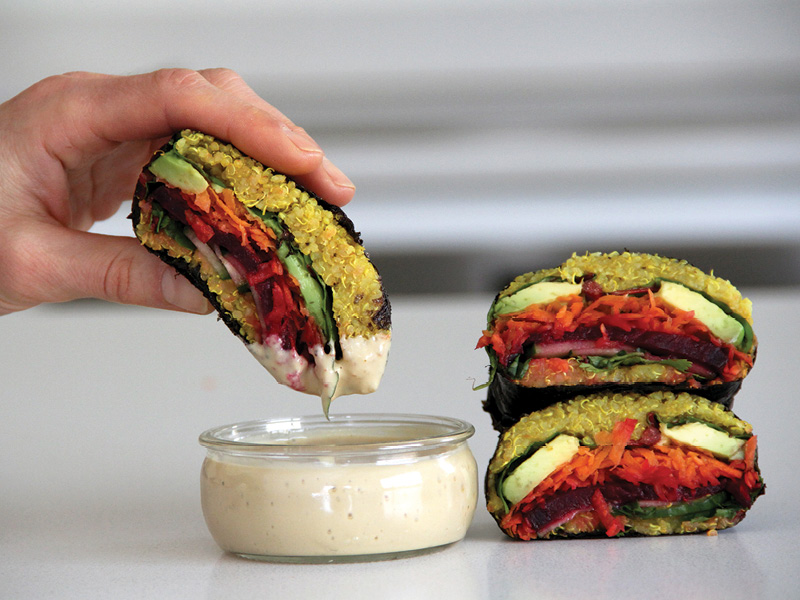A Guide to Essential Sauce Types for Sandwiches
Introduction:
In the culinary world, sauces play a fundamental role in elevating the flavors and enhancing the overall taste of various dishes, including sandwiches. From classic condiments to specialty spreads, the right sauce can make all the difference in creating a memorable sandwich experience. This article aims to explore a wide variety of sauce types that are commonly used in sandwiches, highlighting their distinctive flavors, origins, and popular pairings.
1. Mayonnaise:
A staple in many sandwiches, mayonnaise is a creamy and savory sauce made from egg yolks, oil, and vinegar or lemon juice. Its smooth texture and subtle tanginess complement a range of ingredients, making it a versatile choice for both meat and vegetarian options. Mayonnaise works exceptionally well with deli meats, poultry, seafood, and vegetable sandwiches, adding richness and moisture.
2. Mustard:
With its distinctive spicy and tangy flavor, mustard is a popular condiment that imparts a sharp kick to sandwiches. Available in various forms such as yellow, Dijon, spicy brown, and honey mustard, each type offers a unique taste profile. Mustard pairs exceptionally well with deli meats like ham, turkey, and roast beef, as well as sausages and cheese.
3. Ketchup:
A beloved classic, ketchup is a tomato-based sauce that brings a sweet and tangy burst to sandwiches. Known for its versatility, ketchup complements a wide range of ingredients, from burgers and hot dogs to chicken and vegetable sandwiches. Its vibrant red color and distinct flavor profile make it an essential sauce for many people.
4. BBQ Sauce:
Barbecue sauce is a rich and smoky sauce made from a base of tomatoes, vinegar, sugar, and spices. Its tangy, sweet, and savory notes are a perfect fit for sandwiches containing grilled or smoked meats, such as pulled pork, beef brisket, or chicken. Depending on regional variations, BBQ sauce can range from mildly tangy to spicy and fiery.

5. Hot Sauce:
For those who prefer some heat and intense flavors, hot sauce is a go-to option. Made from chili peppers, vinegar, and various spices, hot sauce adds a fiery kick to sandwiches. With a vast array of brands and flavors available, ranging from mild to extremely hot, hot sauce can be tailored to individual preference. It is particularly popular in sandwiches featuring chicken, seafood, and vegetarian options.
6. Pesto:
Originating from Italian cuisine, pesto presents a unique flavor profile that adds a refreshing twist to sandwiches. Traditionally made with basil, pine nuts, garlic, Parmesan cheese, and olive oil, pesto offers a vibrant green color and a herbaceous, slightly nutty taste. Pesto pairs exceptionally well with chicken, turkey, mozzarella, and vegetable fillings.
7. Hummus:
Hummus, a popular Middle Eastern spread, is made from mashed chickpeas, tahini, garlic, lemon juice, and olive oil. With its smooth and creamy texture, hummus adds a delightful earthy flavor to sandwiches, especially those with Mediterranean or vegetarian influences. Hummus works wonders with falafel, grilled vegetables, or as a spread on pita bread-based sandwiches.
8. Aioli:
Originating from Provence, France, aioli is a garlicky mayonnaise-based sauce that adds a punch of flavor to sandwiches. Made by combining garlic, egg yolks, lemon juice, and olive oil, aioli provides a creamy, tangy, and pungent taste. It pairs beautifully with seafood, roasted vegetables, and grilled sandwiches, adding depth and richness.
9. Horseradish Sauce:
Known for its sharp and spicy flavor, horseradish sauce is made from the grated root of the horseradish plant mixed with vinegar and sometimes mayonnaise or sour cream. The distinct heat and unique tang of horseradish make it an ideal accompaniment for roast beef, pastrami, or corned beef sandwiches. Its intense flavor cuts through the richness of the meats, creating a delightful contrast.
10. Tartar Sauce:
Commonly served with seafood dishes, tartar sauce consists of mayonnaise flavored with pickles, capers, lemon juice, and herbs. This tangy and zesty condiment brings freshness to sandwiches containing fish or seafood, such as fish fillets, crab cakes, or shrimp.

Conclusion:
Exploring the vast array of sauces available for sandwiches allows you to unleash your creativity in the kitchen. Whether you prefer a classic combination or want to experiment with bold, unexpected flavors, the diverse sauce options covered in this article offer something for everyone. Experiment with different combinations and expand your sandwich repertoire, taking advantage of these sauce varieties to enhance every bite. Remember, a well-chosen sauce can elevate a simple sandwich into a truly memorable culinary experience.Title: A Guide to Essential Sauce Types for Sandwiches
Introduction:
In the culinary world, sauces play a fundamental role in elevating the flavors and enhancing the overall taste of various dishes, including sandwiches. From classic condiments to specialty spreads, the right sauce can make all the difference in creating a memorable sandwich experience. This article aims to explore a wide variety of sauce types that are commonly used in sandwiches, highlighting their distinctive flavors, origins, and popular pairings.
1. Mayonnaise:
Mayonnaise is a creamy and savory sauce made from egg yolks, oil, and vinegar or lemon juice. It offers a smooth texture and subtle tanginess that complements a range of ingredients, making it a versatile choice for both meat and vegetarian options. This condiment works exceptionally well with deli meats, poultry, seafood, and vegetable sandwiches, adding richness and moisture. Popular variations of mayonnaise include garlic aioli and chipotle mayo, which provide additional flavors and spice to sandwiches.
2. Mustard:
Mustard is a classic condiment that imparts a sharp kick to sandwiches. With its distinctive spicy and tangy flavor, it adds depth to various ingredients. Available in different forms such as yellow, Dijon, spicy brown, and honey mustard, each type offers a unique taste profile. Mustard pairs exceptionally well with deli meats like ham, turkey, and roast beef, as well as sausages and cheese. Mixing mustard with mayonnaise creates a flavorful combination, commonly known as a “honey mustard” sauce that adds a touch of sweetness.
3. Ketchup:
Ketchup, a beloved classic sauce, is a tomato-based condiment that brings a sweet and tangy burst to sandwiches. Known for its versatility, ketchup complements a wide range of ingredients, from burgers and hot dogs to chicken and vegetable sandwiches. Its vibrant red color and distinct flavor profile make it an essential sauce for many people. Additionally, mixing ketchup with other sauces, such as mayonnaise or hot sauce, can create unique flavor combinations to elevate sandwich tastes.
4. BBQ Sauce:
Barbecue sauce is a rich and smoky sauce made from a base of tomatoes, vinegar, sugar, and spices. Its tangy, sweet, and savory notes are a perfect fit for sandwiches containing grilled or smoked meats, such as pulled pork, beef brisket, or chicken. Depending on regional variations, BBQ sauce can range from mildly tangy to spicy and fiery. Adding a dollop of BBQ sauce to a sandwich not only infuses it with flavor but also enhances the overall experience with a hint of smokiness.

5. Hot Sauce:
For those who prefer some heat and intense flavors, hot sauce is a go-to option. Made from chili peppers, vinegar, and various spices, hot sauce adds a fiery kick to sandwiches. With a vast array of brands and flavors available, ranging from mild to extremely hot, hot sauce can be tailored to individual preference. It is particularly popular in sandwiches featuring chicken, seafood, and vegetarian options. A few drops of hot sauce can transform a plain sandwich into a spicy delight.
6. Pesto:
Pesto, originating from Italian cuisine, presents a unique flavor profile that adds a refreshing twist to sandwiches. Traditionally made with basil, pine nuts, garlic, Parmesan cheese, and olive oil, pesto offers a vibrant green color and a herbaceous, slightly nutty taste. Pesto pairs exceptionally well with chicken, turkey, mozzarella, and vegetable fillings. The combination of pesto with sliced tomatoes and fresh mozzarella creates a classic Italian sandwich known as a Caprese.
7. Hummus:
Hummus, a popular Middle Eastern spread, is made from mashed chickpeas, tahini, garlic, lemon juice, and olive oil. With its smooth and creamy texture, hummus adds a delightful earthy flavor to sandwiches, especially those with Mediterranean or vegetarian influences. Hummus works wonders with falafel, grilled vegetables, or as a spread on pita bread-based sandwiches. The addition of hummus not only adds richness but also provides a healthy, plant-based protein to sandwiches.
8. Aioli:
Aioli, originating from Provence, France, is a garlicky mayonnaise-based sauce that adds a punch of flavor to sandwiches. Made by combining garlic, egg yolks, lemon juice, and olive oil, aioli provides a creamy, tangy, and pungent taste. It pairs beautifully with seafood, roasted vegetables, and grilled sandwiches, adding depth and richness. Adding herbs like dill or basil to aioli can create additional flavor variations, enhancing the overall taste experience.
9. Horseradish Sauce:
Known for its sharp and spicy flavor, horseradish sauce is made from the grated root of the horseradish plant mixed with vinegar and sometimes mayonnaise or sour cream. The distinct heat and unique tang of horseradish make it an ideal accompaniment for roast beef, pastrami, or corned beef sandwiches. Its intense flavor cuts through the richness of the meats, creating a delightful contrast. Horseradish sauce can also be mixed with other sauces, such as mustard or mayo, to create flavorful combinations.
10. Tartar Sauce:
Tartar sauce is commonly served with seafood dishes and consists of mayonnaise flavored with pickles, capers, lemon juice, and herbs. This tangy and zesty condiment brings freshness to sandwiches containing fish or seafood, such as fish fillets, crab cakes, or shrimp. The combination of tartar sauce with grilled fish or crispy seafood adds a burst of flavor and complements the seafood’s natural taste.

Conclusion:
Sauces play a crucial role in enhancing the taste and experience of sandwiches by adding depth, flavor, and moisture. From mayonnaise and mustard to BBQ sauce and hot sauce, each sauce type brings its unique characteristics and flavors to various sandwich creations. Whether you prefer classic combinations or want to experiment with bold and unexpected flavors, the diverse array of sauces covered in this article offers something for everyone. So go ahead, explore these sauce types, mix and match, and let your creativity soar as you create sandwiches that are truly memorable and satisfying.









